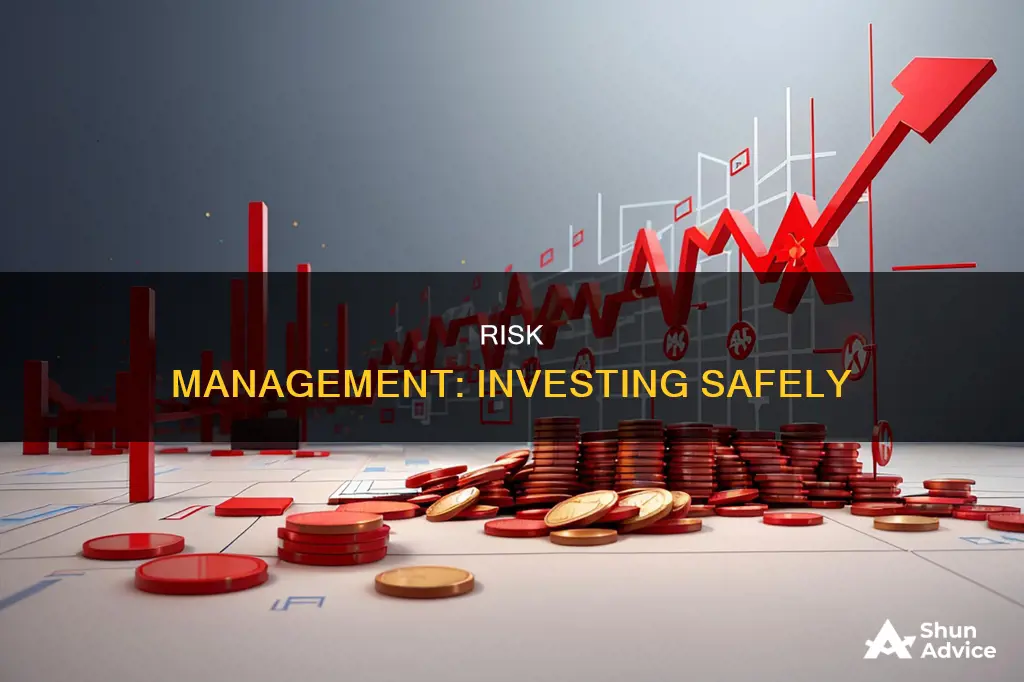
Risk is an inherent part of investing. It refers to the degree of uncertainty in an investment decision, meaning there's no guarantee of making a return or even getting back your original investment. The main risk of investing is the possibility of losing money. However, it's important to note that risk and return go hand in hand—historically, lower-risk investments tend to yield lower returns, while higher-risk investments have the potential for higher returns. The level of risk associated with a particular investment typically correlates with the expected returns.
There are different types of investment risks, including market risk, business risk, liquidity risk, concentration risk, and political risk. These risks can impact your financial welfare and the value of your investments. While it's impossible to eliminate investment risk entirely, it can be managed through strategies such as asset allocation, diversification, and hedging. Understanding your risk tolerance, which is influenced by your experiences, financial status, and goals, is crucial for making informed investment decisions.
What You'll Learn

Risk and return
The relationship between risk and return is crucial in investing. Generally, higher risk is associated with higher potential returns, and investors expect greater returns to compensate for taking on additional risk. This relationship is based on the idea that investors should be rewarded for taking on risky investments. While historical data suggests that certain types of investments, such as stocks, have provided higher average returns over the long term, it's important to remember that past performance does not guarantee future results.
Managing investment risk is essential for investors. While it is impossible to eliminate risk entirely, there are strategies such as asset allocation, diversification, and hedging that can help mitigate potential losses. Diversification, in particular, is a widely recommended approach, where investors spread their investments across different asset classes, industries, and geographic regions to reduce the impact of any single negative event.
It's important to note that risk tolerance varies from person to person and is influenced by factors such as age, financial goals, and investment horizon. Understanding one's risk tolerance is crucial in making informed investment decisions. Additionally, risk management strategies should be tailored to individual needs, as what may be considered a risky investment for one person might not be the same for another.
In summary, risk and return are intertwined in investing, and finding the right balance between the two is essential for achieving financial goals. By understanding the risks involved and implementing appropriate risk management strategies, investors can make more informed decisions and improve their chances of investment success.
Shareholder Equity: Is It Synonymous With Total Shareholder Investment?
You may want to see also

Types of financial risk
Risk is inherent in any business enterprise, and good risk management is crucial for success. While some risks can be directly managed, others are beyond a company's control. Thus, it is essential to anticipate potential risks, assess their impact, and prepare a plan to react to adverse events. Financial risk management is a critical aspect of safeguarding an organisation's finances and preventing financial losses.
There are several types of financial risks that companies face, and these can be broadly categorised into four types:
Market Risk
Market risk arises from substantial changes in the specific marketplace in which a company operates. For example, the rise of online shopping has significantly impacted traditional retail businesses. Market risk also includes the possibility of being outmaneuvered by competitors, especially in a highly competitive global marketplace.
Credit Risk
Credit risk refers to the possibility of a company or a borrower failing to meet their financial obligations, such as payments or bills. Companies can mitigate credit risk through insurance and collateral, but some parties may still default.
Liquidity Risk
Liquidity risk pertains to a company's ability to convert its assets into cash and its daily cash flow. It includes asset liquidity, referring to the ease of converting assets into cash, and operational funding liquidity, which is the daily cash flow. Poor cash flow management can put a company at substantial risk, as it may suddenly find itself unable to pay basic expenses.
Operational Risk
Operational risk emerges from a company's regular business activities and includes unforeseen events, fraud, lawsuits, and personnel issues. Operational risks can have a significant impact on a company's bottom line and are challenging to eliminate entirely. However, implementing effective internal controls, processes, and systems can help manage these risks effectively.
Other types of financial risks include:
- Legal or Compliance Risk: The risk of financial loss due to failing to meet legal, regulatory, or compliance requirements.
- Foreign Exchange or Currency Risk: The risk associated with fluctuations in foreign currency exchange rates, which can impact the valuation of a company's investments and financial positions, especially for multinational corporations.
- Business Risk: The basic viability of a business, including its ability to generate sufficient revenues to cover operational expenses and turn a profit.
- Interest Rate Risk: The risk of an investment's value changing due to fluctuations in interest rates, primarily affecting the value of bonds.
- Political Risk: The risk of an investment's returns suffering due to political instability or changes in a country, also known as geopolitical risk.
Understanding these types of financial risks is crucial for effective financial risk management. By studying these risks and implementing best practices, organisations can improve their financial decision-making and safeguard their finances.
Alternative Investments: Hedging Risks and Diversifying Portfolios
You may want to see also

Risk and diversification
Risk is inherent in any investment decision. It refers to the degree of uncertainty about the outcome of an investment, including the possibility of losing money or not achieving expected returns. Diversification is a key strategy for managing risk, and it involves spreading investments across different types of securities, industries, sectors, and regions to reduce exposure to any single source of risk.
Understanding Investment Risk
The main risk of investing is the potential loss of money, either partially or entirely. The outcome of investments is uncertain due to various factors, including market volatility, company performance, and economic issues. Risk and return are closely linked; historically, lower-risk investments tend to have lower potential returns, while higher-risk investments offer higher potential returns.
Managing Risk through Diversification
Diversification is a fundamental strategy for managing investment risk. It involves spreading investments across different types of assets, industries, sectors, and geographic regions. By diversifying their portfolios, investors can reduce their exposure to any single source of risk. For example, if one investment performs poorly, it may be offset by positive returns from other investments.
Types of Investment Risk
There are various types of investment risks, including market risk, business risk, liquidity risk, concentration risk, and political risk. Market risk refers to the potential impact of market conditions on investment value. Business risk arises from corporate decisions and performance. Liquidity risk pertains to the ease of converting investments into cash. Concentration risk is higher when a significant portion of an investor's wealth is concentrated in a single investment or a small number of investments. Political risk relates to the potential impact of political events or policies on investments, especially in international markets.
Implementing Diversification Strategies
To achieve effective diversification, investors can spread their investments across different vehicles such as stocks, bonds, mutual funds, exchange-traded funds (ETFs), and cash. It is also important to diversify within each investment type by considering factors like sector, industry, region, and market capitalization. Additionally, including investments with different risk levels can help ensure that gains in some areas offset losses in others. Regular "check-ups" or rebalancing of portfolios help investors maintain a risk level consistent with their financial strategy and goals.
Limitations of Diversification
While diversification is a powerful tool, it is essential to recognize its limitations. Diversification primarily helps manage unsystematic risks, which are specific to individual companies or industries. However, it is less effective against systematic risks, such as interest rate risk, inflation risk, and currency risk, which affect the entire market or a large portion of it. To mitigate systematic risks, investors can consider strategies like hedging, investing in assets with lower correlation to systematic risks, or adjusting their investment time horizon.
Debt and Equity: What Securities Can You Invest In?
You may want to see also

Measuring and quantifying risk
Risk management is about understanding and mitigating risk, rather than avoiding it entirely. Measuring the potential risks provides investors with the tools to assess the potential downsides of their investments. These methods range from simple statistical measures to complex mathematical models, each offering unique insights. By quantifying the risks, investors can align their portfolios with their risk tolerance and financial goals.
Standard Deviation
Standard deviation is a well-known statistical measure that quantifies the dispersion of data from its mean. In finance, it is used to measure the historical volatility of an investment relative to its annual rate of return. A high standard deviation indicates greater volatility and therefore a higher degree of risk.
Value at Risk (VaR)
VaR is a statistical measure of the potential loss of a risky asset or portfolio over a given period, for a given confidence interval. It provides a single, easy-to-understand number that encapsulates the downside risk of an investment. For example, a portfolio with a one-year 10% VaR of $5 million has a 10% chance of losing $5 million over that year.
Conditional Value at Risk (CVaR)
CVaR addresses some of the limitations of VaR by measuring the expected loss if the loss is greater than the VaR. This provides investors with a maximum potential loss for outcomes that are less likely to occur.
Beta
Beta measures the volatility of a security or sector relative to the entire market. It provides a quick way to assess an investment's volatility compared to a benchmark, usually the broader market. A beta of one indicates the same volatility as the market, a beta greater than one indicates higher volatility, and a beta of less than one indicates lower volatility.
Sharpe Ratio
The Sharpe ratio enables investors to assess the excess return they are receiving for the extra volatility of holding a specific asset. A higher Sharpe ratio indicates better risk-adjusted performance.
R-squared (R2)
R-squared represents the percentage of a fund or security's movements that can be explained by changes in a benchmark index. It is useful for assessing how closely a fund tracks its benchmark and determining the relevance of other metrics like alpha and beta.
Modern Portfolio Theory (MPT)
MPT assesses the maximum expected portfolio return for a given amount of portfolio risk. It involves constructing an optimal portfolio based on asset allocation, diversification, and rebalancing.
Capital Asset Pricing Model (CAPM)
CAPM is an equilibrium theory that helps investors measure the risk and expected return of an investment to price the asset appropriately. It is based on the relationship between risk and expected return, where the expected return will be higher when the investor bears greater risks.
Alpha
Alpha is a statistical metric that measures the performance of an investment portfolio and compares it to a benchmark index. A positive alpha indicates the portfolio has outperformed the benchmark, while a negative alpha indicates underperformance.
Risk Measurement vs Risk Assessment
Risk measurement generally involves using statistical tools and metrics to provide numerical values that represent the degree of risk associated with an investment. Risk assessment, on the other hand, has a broader scope and involves identifying, analyzing, and prioritizing potential risks. It is more qualitative and strategic, often involving scenario analysis and expert judgment.
Streamline Your Parking: Invest in Smart Management Solutions
You may want to see also

Risk management strategies
Risk management is a crucial aspect of investing, as it helps to mitigate potential losses and protect an investor's financial welfare. While it is impossible to eliminate investment risk entirely, several strategies can be employed to manage and reduce risk. Here are some essential risk management strategies:
- Diversification: Diversification is a fundamental strategy to minimize risk. It involves spreading investments across different asset classes, sectors, and industries to reduce exposure to specific risks. By diversifying, investors can balance out potential losses in one area with gains in another. This strategy is based on the concept of correlation and risk, where a well-diversified portfolio contains assets with varying degrees of risk and correlation. Mutual funds, for instance, offer investors access to multiple assets within a single fund.
- Asset Allocation: This strategy involves allocating investment capital across different asset classes, such as stocks, bonds, real estate, and commodities. By allocating assets strategically, investors can protect their portfolios from market volatility and economic shifts. For example, when some stocks drop in value due to economic changes, other assets that are less vulnerable to those conditions can help offset the losses.
- Hedging: Hedging is a risk management technique where investors buy a security or make a transaction to offset potential losses on another investment. While hedging can provide additional protection, it often adds significant costs to the investment and may involve speculative activities.
- Insurance Products: Utilizing insurance products can be another way to manage risk. Similar to hedging, insurance products can protect against potential losses, but they typically come at a cost that can eat into investment returns.
- Tax Planning: Incorporating tax strategies into investment planning can help minimize the tax burden associated with investment gains. For example, tax-efficient investments or tax-loss harvesting techniques can be employed to offset losses and maximize after-tax returns.
- Emergency Fund: Maintaining an adequate emergency fund is crucial to avoid liquidating investments prematurely to cover unexpected expenses. A general guideline is to hold at least six months' worth of living expenses in a dedicated savings account or money market fund, ensuring accessibility and interest earnings.
- Risk Tolerance Assessment: Understanding one's risk tolerance is vital for making informed investment decisions. Investors should assess their comfort level with risk and ensure that their investment choices align with their long-term financial goals and risk appetite.
- Consulting Professionals: Working with financial advisors or wealth managers can be beneficial. These professionals can provide personalized investment plans that balance potential gains with risk, taking into account an individual's unique financial situation and goals.
- Dollar-Cost Averaging: This strategy involves investing consistently over time, regardless of market prices. By investing a fixed amount at regular intervals, investors benefit from dollar-cost averaging, reducing the average cost per investment over time. This approach removes the pressure of timing the market and helps investors stay focused on their long-term goals.
- Asymmetric Risk Investment: This strategy focuses on maximizing potential gains while minimizing potential losses. It involves seeking opportunities with high potential returns and limited downside risk, where the potential reward far outweighs the potential risk. Leveraging can be used to control a larger position with a smaller upfront investment, but it is important to protect against substantial losses using strategies such as stop-loss orders.
- Low-Volatility Options: For risk-averse investors, increasing the allocation of low-volatility options like bonds in their portfolio can help reduce overall volatility. Bonds offer reliable and predictable returns and are less exposed to market fluctuations than stocks.
- Alternative Investments: Diversifying beyond traditional assets into alternatives like real estate and cryptocurrencies can be a useful tool for reducing portfolio volatility. These investments do not correlate closely with the stock market and can provide steady returns during volatile periods. However, alternative investments should be used cautiously and comprise only a small percentage of the portfolio to avoid adding excessive volatility.
Debt and Equity: Understanding Investment Securities
You may want to see also
Frequently asked questions
Investment risk refers to the degree of uncertainty inherent in an investment decision. There is a possibility of losing money and not achieving your expected returns. The outcome of any investment is uncertain due to unpredictable market behaviour and economic issues.
Risk and return are closely linked. The greater the amount of risk an investor is willing to take, the greater the potential return. Lower-risk investments typically contain a mix of cash and fixed-income assets, while higher-risk investments may have more equities.
While it is impossible to eliminate investment risk, it can be managed through diversification and asset allocation strategies. Diversification means putting your money in a range of investments to balance potential losses. Hedging and insurance products can also help manage risk but may add significant costs to your investment.
The longer your investment horizon, the greater the risk you can afford to take as you have more time to recover from market downturns. However, it's important to note that stocks do not become safer the longer you hold them, and there is always some degree of risk involved in investing.







